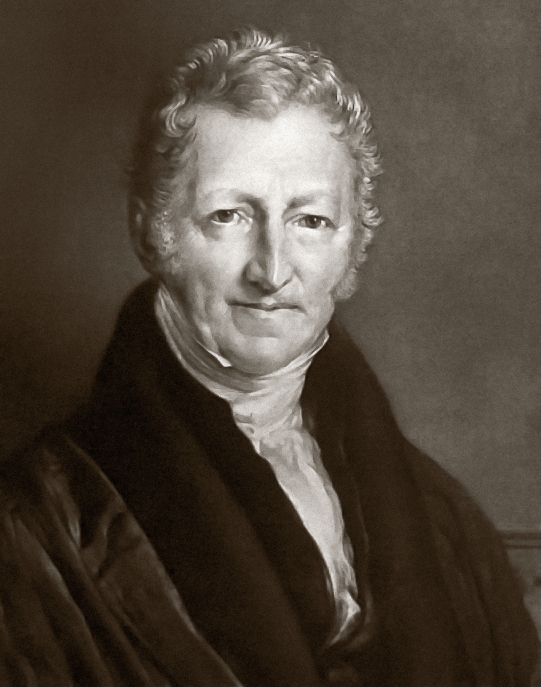
I learned this today. The Malthusian theory of population doesn’t apply today because we can basically produce more food than was previously possible.
Thomas Malthus lived from 1766 to 1834 and he was an English cleric, scholar, and economist. Malthus did a lot of work, but he is primarily remembered for the theory on population that he wrote in 1798. He presented it in an essay called An Essay on the Principle of Population.
Malthus’ basic idea was that populations grow exponentially (2, 4, 8, 16 …), but food reserves grow arithmetically (2, 3, 4, 5 …). He theorized that populations would grow until they outstripped the food sources and then something would occur to lower the population back to a sustainable level. For example, a famine or a plague.
There is some argument that Malthus might have been correct at about the time he was writing, or slightly before, but circumstances changed during his lifetime.
Malthusian population theory does apply to animals. With any animal and its food source, there is an obvious limit. For example, deer eat grasses and leaves. If the number of deer goes up, they eat more grasses and leaves. Once they reach a point where there isn’t enough food for them, the deer will start to die off until their number goes down to a sustainable number. And this cycle repeats.
In Malthus’ defense, it would have seemed that the same thing happened to humans over time. Every time the population went up, there was a plague or a famine that brought the numbers back down.
It is impossible to know the population of the world before modern record keeping methods were developed, but experts have estimated. 70,000 years ago, the world population was probably about 10,000 people. In 10,000 BC, it was probably about 15 million people. In 400AD, it was probably 60 million. A plague in 541-549AD brought it down to 30 million. In 1300AD, it was probably 450 million and the plague in 1340 brought it down to 350 million. Just after Malthus was writing, in 1804, the world’s population hit 1 billion.
Malthus looked at the world around him and decided that what was true for nature was true for humans. He analyzed the ways that people farm and the available land. He calculated that there wasn’t enough available land on the face of the Earth to sustain continued population growth.
The problem was, that his theory was probably correct during his grandfather’s time, but when he started writing about it he was no longer correct, thanks to the Agricultural Revolution and the Industrial Revolution.
The Agricultural Revolution started in Britain in about 1650. Over the space of about 200 years, there were huge changes in farming techniques and equipment that vastly increased the amount of food that could be produced. Some of these improvements were: four-course crop rotation, changes to the plough, the introduction of new crops from the Americas and Asia (specifically the potato), farm sizes increased, regional markets and trade increased, transportation infrastructures developed, drainage was improved, the number of domestic farmers increased, there was selective breeding of livestock, seeds were planted rather than scattered, and fertilizers were introduced. Between 1700 and 1870, agricultural output grew by 2.7 times.
The Industrial Revolution also had a major impact. It is partly due to the Industrial Revolution that transport networks developed, but it was also responsible for (or was the result of) a new, scientific way of thinking. This was then applied to agriculture and agricultural equipment.
That scientific way of thinking is why the Malthusian theory of population is not accurate today. Animals are affected directly by their food source, but we are able to use technology to increase our food source.
Today (21st January 2022), the world’s population is 7.9 billion people. It is projected to cross 8 billion either later this year or early next year. It reached 1 billion in 1804, 2 billion in 1927, 3 billion in 1960, 4 billion in 1974, 5 billion in 1987, 6 billion in 1999, and 7 billion in 2012. The population is projected to reach 9 billion in 2037, 10 billion in 2057, and possibly 11 billion in 2100. The birth rate is slowing, and after 2100 it is predicted to fall again.
Currently, global food production is incredibly efficient, and we produce enough food to feed 10 billion people. Technology is advancing at such a rate that it is safe to assume that we will be able to feed 11 billion people. The problem we have is not that we can’t feed enough people. The problem we have is that we can’t get the same amount of food to all of the people on the Earth. Some have far too much and some not enough. Hunger Zero is the goal, and it is completely achievable because Malthus was not right. And this is what I learned today.
Image By John Linnell, Public Domain, https://commons.wikimedia.org/w/index.php?curid=7318108
Sources
https://en.wikipedia.org/wiki/Malthusianism
https://en.wikipedia.org/wiki/Thomas_Robert_Malthus
https://byjus.com/biology/malthusian-theory-of-population/
https://www.scientificamerican.com/article/why-malthus-is-still-wrong/
https://en.wikipedia.org/wiki/World_population
https://examples.yourdictionary.com/common-predation-examples-in-biology.html
https://en.wikipedia.org/wiki/British_Agricultural_Revolution
https://www.worldometers.info/world-population/
https://en.wikipedia.org/wiki/Projections_of_population_growth
